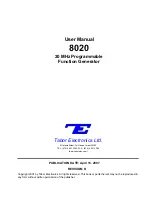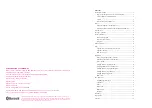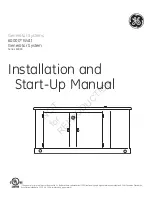
©
2017 Sensata Technologies
Page 39
Parallel Operation
4.0 Parallel
Operation
This section provides information about operating MS-PAE Series inverters in parallel.
Info:
The ME-RTR owner’s manual provides additional detailed installation information
on parallel stacking.
Info:
The optional panels (MP) and MPX Series extension boxes are designed to make
multiple-inverter applications easy to install. The MP Series enclosure is pre-wired and
includes all the major components necessary to set up, monitor and operate multiple
MS-PAE inverter/chargers together. The MPX Series comes with the required AC/DC
breakers and wiring that enable you to mount and connect additional MS-PAE inverters
to the MP Series system’s panels.
WARNING:
The information is this section is meant to supplement the information in
previous sections. To prevent personal injury or equipment damage, you must carefully
read and follow all instructions and warnings in this operator’s manual.
4.1 Overview
A single MS-PAE inverter produces 120/240 VAC at its rated power (i.e., MS4024PAE provides 4000
watts of inverter power). When multiple MS-PAE inverters are stacked together in parallel (using the
required ME-RTR router), the inverters work together as a single inverter/charger system. Because
the stacked inverters operate as a single unit, this results in increased continuous and surge capacity,
increased charging capability to the battery bank, and increased AC pass-through capacity.
4.2
Parallel System Requirements
When connecting units in parallel, the following requirements must be met.
Info:
MP Series enclosures meet the requirements needed to stack MS-PAE inverters
and are UL-listed/CSA certi
fi
ed for a code compliant installation.
• Only MS-PAE Series inverters are capable of being stacked in parallel—the models must be
identical (i.e., all MS4024PAE models, or all MS4448PAE models).
• A maximum of four identical MS-PAE inverters can be connected in parallel.
• The ME-RTR router must be directly connected to each MS-PAE inverter in order to communicate
and synchronize for parallel operation.
• The RJ45 stack cables (two are provided with the ME-RTR) must be used to directly connect
the ME-RTR to each inverter. This stacking cable is the only one that satis
fi
es the parallel
system’s size, data and insulation requirements, and meets NEC/CEC site approval.
• Every inverter in the parallel system must be connected to the same battery bank.
• The DC connection cables from the battery to each inverter must be of equal length and size.
• There must be a separate cable run from each inverters positive terminal to the battery
bank [thru an overcurrent protection device (i.e., breaker)].
Note: If you connect the cables
together - other than at the battery bank - and a cable fails, there is the possibility of pulling
too much current through the remaining cables.
• The inverters’ negative terminals must be connected together, either at the inverters or at a
location close to the inverters (within 18 inches/0.5 meters).
• The AC input cables to each inverter must be of equal length and size. The AC output cables
to each inverter must be of equal length and size.
Note:
The length of the AC input cables may
be different than the length the AC output cables.
• The MS-PAE inverters should be no more than 6” (15 cm) from each other—to allow the 6-foot
stacking cables to connect to each inverter—but allow at least 3” (7.6 cm) between, under,
above, and in front of the inverter for ventilation purposes.
• The AC input to every inverter must be from the same AC source, and the two 120 VAC legs
from that AC source into each inverter input must be 180° out-of-phase from each other.
• Each inverter must have appropriate AC and DC overcurrent protection.
















































